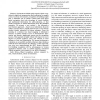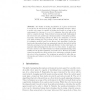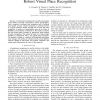26 search results - page 4 / 6 » Performance Comparison of Landmark Recognition Systems for N... |
ICRA
2005
IEEE
14 years 1 months ago
2005
IEEE
Abstract— Autonomous mobile agents require object recognition for high level interpretation and localization in complex scenes. In urban environments, recognition of buildings mi...
IBPRIA
2005
Springer
14 years 1 months ago
2005
Springer
The ability of finding its situation in a given environment is crucial for an autonomous agent. While navigating through a space, a mobile robot must be capable of finding its lo...
IROS
2006
IEEE
14 years 1 months ago
2006
IEEE
— An important competence for a mobile robot system is the ability to localize and perform context interpretation. This is required to perform basic navigation and to facilitate ...
ICML
2010
IEEE
13 years 7 months ago
2010
IEEE
We present an overview of FAB-MAP, an algorithm for place recognition and mapping developed for infrastructure-free mobile robot navigation in large environments. The system allow...
TROB
2002
13 years 7 months ago
2002
Abstract-We describe Localization-Space Trails (LOST), a method that enables a team of robots to navigate between places of interest in an initially unknown environment using a tra...



